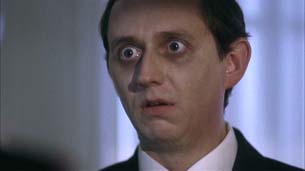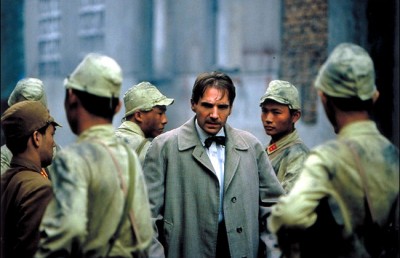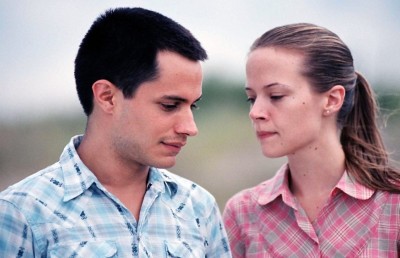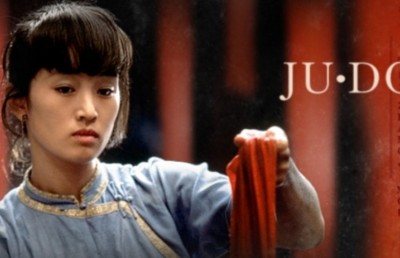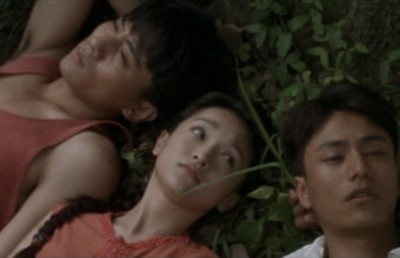The 4th Life
A Sapphic Film Noir
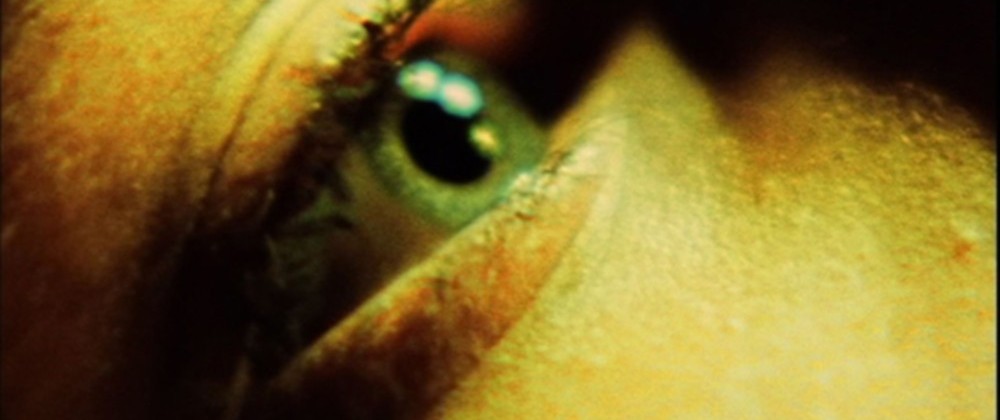
Montreal-based filmmaker and teacher (Concordia University) François Miron has been making award winning experimental films since the late 1980’s. Miron received his MFA in filmmaking from the School of The Art Institute Of Chicago, and his thesis film What Ignites Me, Extinguishes Me was awarded Best Experimental Film at the 1990 Festival Of Illinois Film And Video Artists. His 1994 film The Evil Surprise won a special Jury award as best Experimental film at the Ann Arbor Film Festival. Miron’s latest film The 4th Life marks his entry into narrative feature film, which may seem odd in light of the noted background in experimental film (which were abstract and marked by impressive optical printing work). However, fans of Miron’s earlier work can take heart: Miron has not exactly made a commercial feature for the mallrats. In some respects Miron’s previous film, Resolving Power (2001), can be seen as a transitional film between his experimental films and the narrative/character-based The 4th Life. I wrote the following about Resolving Power when it played at the 2001 Fantasia Film Festival:
…François Miron tries his hand at, what is for him, a less abstract foray which is at once playfully philosophical and visually mesmerizing….The film stars local musician/comic book artist/filmmaker Rick Trembles as an electrical worker who somehow zaps himself back into a primordial sludge …. No story here, no connect the dots symbolism, just a lot of plain weird post-??Eraserhead?? imagery, curious wide angle aesthetics … and resonating recurring images, or more accurately, figures and shapes (the optical black and white pattern that opens the film, the animated comic book style lightning and electric flashes, the black circles and lines on white paper, etc.). Somehow they all connect to the maze of the mind, or perhaps the beginning of time…. Miron alternates between low-tech effects and smooth dolly shots of Trembles walking cartoon-like through the frame, past electric towers and post-apocalyptic landscapes. He gets stuck in a room that turns him into a negative image. The film ends with his body literally becoming electric (his eyes moving in electrical zigzags), finally “resolving the power”…. In its own quiet way Resolving Power shows us the true face of technology: dirty, grimy, ecologically damning, all-encompassing, able to insinuate itself into our lives and take over our minds and bodies.
While The 4th Life relies more on conventional narrative tropes (plot, characters, recognizable places, etc.) than Resolving Power, it retains the latter’s sense of strong visual design (more accurately, audio-visual design, because of the integrated sound design work by the ever busy David Kristian), which ‘mutes’ plot in favor of texture and sensuality. For example, while the film’s plot is simple –obsessive love leading to violent revenge– the ‘what’ (plot) is made fresh and fascinating by the ‘how’ (style). One of the more striking elements of this ‘how’ is the montage of the film’s elliptical narrative structure, which continually disorients the viewer by cutting to several connected points within the five or so year span of the story. And what is the story? (WARNING: THIS REVIEW CONTAINS SPOILERS)
The 4th Life is a kaleidoscopic exploration of obsessive love detailing the on/off relationship of the dark haired, overly protective, and dangerous, Caz (Andrea Sheldon, Gothika), and the blonde, level-headed tough gal Marie (Janet Lane). The film is set in a near future where a destitute city named ‘Darkeville’ (perhaps a joke on ‘Sin City’) is ravaged by ‘environmental’ terrorists (who routinely set bombs to “starve the machine”), heightened urban crime, and random street violence. Caz, having escaped from an asylum for the criminally insane with a dim witted, mute male accomplice named George (“Dimmer than a 10 watt bulb,” states Caz), continues her earlier life of crime (breaking and entering homes to rob and then sell the goods). Marie, who we later learn was a criminal accomplice with Caz and her former lover, is currently tracking down precious objects for her antique dealer/husband John from a rich industrialist named Mr. Farquate (Frederic Smith). We learn that Caz and Marie share a traumatized past at the hand of abusive parents and authority figures; while Caz reacted to her abusive past by turning to a life of violence and crime, Marie now suffers from blurred vision as a result of the internalized psychic pain. Unable to cope with Caz’s suffocating love, Marie leaves Caz, which sends her to Darkeville in murderous pursuit of her former lover.

During her search for Mr. Farquate Marie meets a loner cab driver named Buzz (Vitali Makarov). Buzz describes Mr. Farquate and his son Reginald as “enemies of the people” who used to own the town but whose shady business practices destroyed its economy. Marie uses Buzz to help find Mr. Farquate (which includes a brief respite of sex in his cab), and then learns from the weak, snivelling son Reginald (Shaun Balbar) that his father’s empire collapsed, forcing him to sell all of his antique collection. Meanwhile Caz, who has killed Marie’s husband John, tracks Marie down at a two-bit hotel in Darkeville, which leads to the film’s rooftop chase/climax.
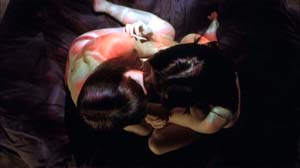
While I’ve necessarily ‘untangled’ the plot in my retelling, The 4th Life plays completely different, more like a fever dream fragmented across various points along the timeline of the Caz/Marie relationship in a manner reminiscent of the films of Nicolas Roeg and Donald Cammell. For example, the film begins strikingly with a sustained overhead long take which slowly and sinuously booms up/down from a bed where two nearly nude female lovers (Caz and another brown-haired lover, Loz) are entwined in rapturous French-kissing. After this credit sequence the film begins with an extreme close-up of an eye, light flickering and pulsating in unison to David Kristian’s sonic waves. The eye shot is intercut with moving point of view shots (from a train) of passing verdant landscape (the mood here is not unlike the trolley ride in Stalker). We then cut to a shot of the face, Marie’s, which situates the experience within her subjectivity. This cuts back to another love scene between two women, the image blurred as if seen through a glass; back to the moving point of view shots, and then to a focused shot of Marie lying with Caz on a red bed cast against a stark black background, and the film’s first bits of dialogue, Caz: “You’re beautiful Marie. And you’re mine. I’m never going to let you go.” (I’m sure it must be me, but this theatrical set, with the blood red bed sheets, black background, and overhanging phallic silver beams, reminded me of a set from a Jesus Franco film.) This bed scene tryst then cuts abruptly to a close-up of Marie in another time/place, rising quickly and blinking as if waking from a bad dream. Marie, her eyes still flickering, takes in a breath from her inhaler, and then the shot cuts to another distorted POV shot, with Caz’s words echoing in Marie’s head (“You’re beautiful…and you’re mine”).

In all but a few minutes Miron establishes the film’s elliptical, back/forward time line, and the film’s primary thematic/visual motif of the eye/perception, which is rendered directly through Marie’s psychically-induced blurring spells, and indirectly through visual touches such as the blind Mr. Farquate’s egg shell colored eyes, the several extreme close-ups of eyes, and other in-camera visual effects such as prismatic images and wide angle distortions.
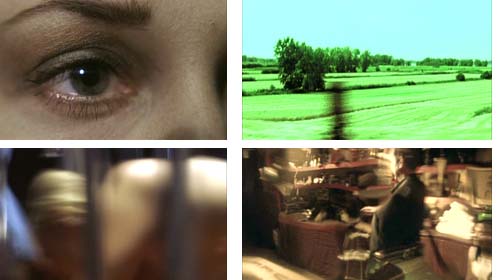
The meaning and genesis of the eye motif is given its narrative explanation in one of the film’s best scenes, a flashback to the traumatic event in Marie’s childhood which triggered her vision problems. The scene, filmed in stylized high contrast grain and saturated color, sees an adolescent, tentative Marie (in these scenes the young Marie is played by Shiloh Sharay) having dinner with her uncaring, irresponsible mother Celia (Nicole Braber) and her mother’s lecherous boyfriend Stewart (Michael Rigby), who tries to come across as an ‘uncle’ figure to Marie. After dinner Stewart enters Marie’s bedroom with the intention of raping her. The terrified Marie stabs Stewart with a kitchen knife and, momentarily blinded from the trauma, accidently stabs her mother, who has since entered the room. This event is cross cut with slow motion, similarly saturated images of Caz, candelabra in hand, walking up a winding staircase leading to Marie’s bedroom.
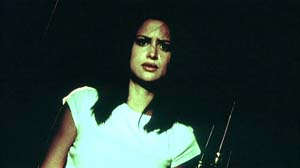
The closer she nears the room, the louder the heavy, guitar-driven music becomes, culminating with a mysterious gust of wind that blows out the candles. Caz enters the bedroom after the violent aftermath, with Celia and Stewart lying dead, and comforts the traumatized Marie (filmed in an overhead angle echoing earlier shots of the them together).
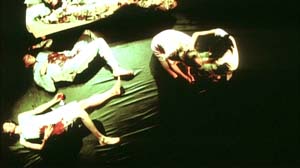
Why and how did Caz find herself at Marie’s house at this precise moment (was she on a breaking and entering)? Why does she not appear at the same young age as Marie? Indeed, is this a fantasy wish-fulfillment reconstruction of how they met? Or of how Caz sees herself as Marie’s ‘saviour’? These questions are all left open. However, this (Oedipal?) scene –whether fantasy or not– explains how Caz’s obsessive love for Marie is a by-product of her violent psycho-sexual fantasies.
The film concludes with an interesting mix of cliché and innovation. A little over an hour into the film Caz and George arrive at the Majestik Hotel looking for Marie. Wearing a red coat and gun in hand, Caz asks the clerk for information about Marie. The dialogue exchange between Caz and the clerk is fragmented by audacious continuity edits across time. The clerk responds to Caz and George’s aggressive incursion with the phrase, “Damn punks,” and the shot cuts to a close-up of Caz, wearing a similar red coat, seemingly replying to the clerk, “What did you say?” However, we hear Marie responding to Caz, which situates this as a past event. Back in the present, Caz finally catches up to Marie in her hotel room. A struggle for Caz’s gun ensues, resulting in George being accidentally killed by an errand bullet. Caz chases Marie through the dark city back alleys, up wrought iron stairs to a rooftop, where they continue fighting. This is the point where cliché enters, with the scene cross cutting between Caz and Marie fighting (the present) and Caz and Marie making love (the past). While this juxtaposition of fighting with lovemaking can appear cliché, it perfectly symbolizes the extreme range of Caz’s emotions, passionate love or psychotic anger, with their bodies fittingly entangled in both cases. Their rooftop struggle concludes with Caz falling backwards off the roof to the landing below. Gasping her last breath, Caz points her gun at Marie looking down at her from high above on the rooftop and continually pulls the trigger. The possible sounds of the gun shots are masked by a catchy, electro-pop song. At this moment the scene cuts to a close-up of a time bomb, which we saw set by an environmental terrorist group earlier in the film, seconds from detonation. A quick cut back to Caz is followed by an explosion of a beautiful white, swirling bomb cloud. No sooner than the cloud fills the screen, the image begins to play backwards in slow motion until it evaporates, as if the bomb had never gone off or as if time is playing by its own mysterious rules.
The scene cuts to a desolate highway road at dawn (or dusk), with a corpse lying on the road visible in the extreme background. A closer shot reveals it is Marie, her clothes in tatters and skin covered in dirt and cinder. We assume that she has survived the explosion (or is awaking from a dream?). A car drives up beside her. The door opens and we get a brief glimpse of the driver, long enough to acknowledge it is Buzz, the cab driver Marie met in Darkeville. Marie enters the car and shuts the car door. However, the next shot brings us to the inside back seat of the car, where we see Caz, not Buzz, seated in the driver’s seat next to Marie, and the following cryptic exchange which concludes the film:
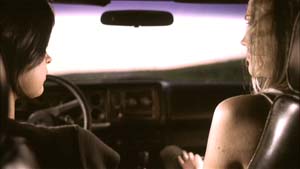
Caz: “So, where do we go from here?”
Marie: “What the fuck happened?”
Caz: “Everything is gone. Everyone is dead. There is no light at the end of the tunnel.”
Marie: “Let’s go south. I’ve been everywhere else.”
The final image is of the car driving off into the distance. What can we make of this enigmatic (and quite frankly, liberating) ending? Is it Marie’s fantasy? Or Caz’s posthumous dream-fantasy of living in a world alone with Marie? Or perhaps one can project the image of Caz as a perceptual fantasy on the viewer’s part, and read the ending ‘realistically,’ with Marie driving off with Buzz? Intertextually, the ending recalls that of Bladerunner, where the two ill-fated lovers Deckard and Rachel drive off into an uncertain future. Or perhaps one can imagine an alternative film history where “Thelma and Louise” do not drive off the cliff!
The 4th Life is a Sapphic film noir imagined in world where women “take shits” and slap men around like Humphrey Bogart, and men are nervous, jittery and timid. There is not one male character in this film who could take a turn in a classic era noir. Caz’s accomplice George is mute and is at her beck and call; Mr. Farquate is wheelchair bound and blind; his son Reginald meek and neurotic (and gets slapped by Marie like Bogart’s Sam Spade slaps Peter Lorre’s Joel Cairo in The Maltese Falcon); Marie’s husband John dies as a result of being strapped to a chair and electrocuted by Caz (although Caz tells Marie he died because he could not take his medicine); the hotel clerk who serves Marie is clearly intimidated by her mere presence; and even Buzz, who sleeps with Marie, does so on her terms, with Marie on top riding him like a hobby horse.

In short, Miron takes the traditional high testosterone noir world and cleverly turns it on its phallic head. While blending all the above as part of its noir revisionism, The 4th Life also weaves a rich visual tapestry of different textures (black and white, color, grainy, overexposed) and tones (comic, reflexive, poetic, sensual). While all of this might sound dark and sinister, it is equally true that, with the film’s sometimes brash music cues, selected over-the-top performances (Shaun Balbar as Reginald), and intentionally cliché touches (‘Darkeville’ and ‘Sunnytown’), Miron’s tongue is never too far from his cheek, which would help explain the allusion to such other films as Blood Feast (“Have you ever had an Egyptian feast?”), The Big Sleep (Mr. Farquate’s reclusive, big game hunter is an echo of Gen. Sternwood), Bound (the lesbian couple in a noir setting), and, perhaps even Miron’s own earlier short, Resolving Power (by making Caz’s preferred method of killing electrocution).
